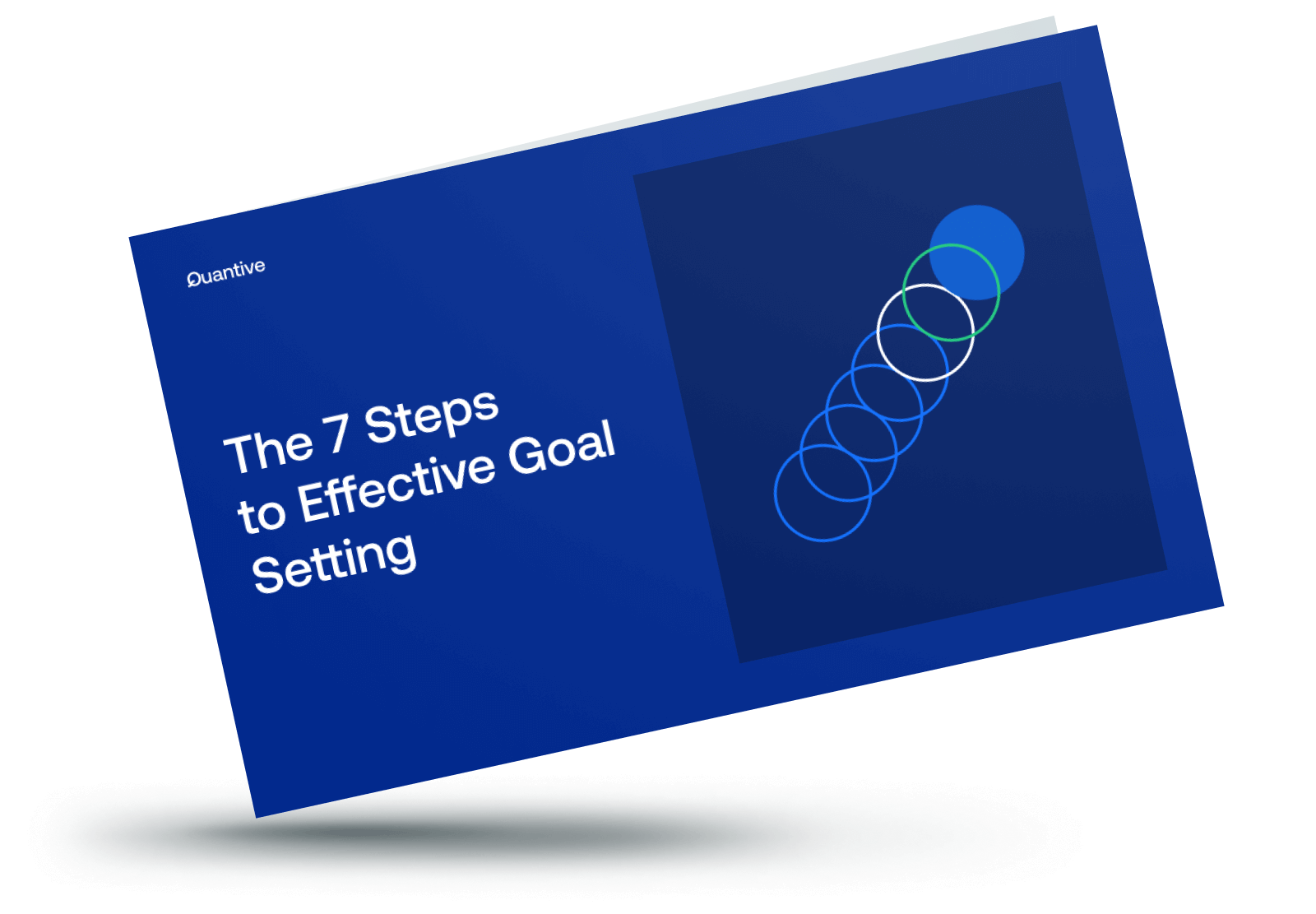Quantive is now part of WorkBoard. Get to know WorkBoard:
Companies that want to create impactful change need a well-defined goal setting process. Using an effective goal setting approach, you can establish and encourage steady goal progress while keeping employees motivated and accountable.
In this article, we’ll cover everything you need to know about creating a successful goal setting process, covering:
- What is goal setting
- Why goal setting is important
- Types of goals
- Goal setting frameworks
- 7 goal setting steps
- Tips for an effective goal setting process
Don't have time to read the full article now? Download the pdf and save for later

What is goal setting?
A well-defined goal setting process is a surefire way to improve your organization’s performance and reach new levels of success. In a business environment, goals are achievements you want to attain at the organization, team, or employee level over a specific period of time.
As a powerful driver of motivation and learning, effective goal setting involves using a structured working model to approach your goals. That is, using the goal setting theory as a model for understanding the components of a practical goal.
Back to basics: The goal-setting theory
The goal-setting theory honed by Edwin Locke and Gary Latham in 1990 highlights the correlation between goal setting and performance, stating that specified and well-defined goals can enhance productivity. They proposed that such goals can motivate individuals to do their best by cultivating focus, effort, and perseverance.
The goal-setting theory is said to work when you meet five critical conditions:
- Clarity: Goals must be specific and measurable, letting employees know what they’re striving to achieve
- Challenge: Goals should be challenging yet attainable, as easy goals won’t encourage employees to put their best foot forward
- Commitment: Employees need to support the goals they’re working towards and commit themselves to achieving these
- Feedback: Feedback helps employees determine how well they’re performing and what they need to change to improve results
- Task complexity: Employees need an adequate timeline for their goals — one that accounts for the learning curve and task complexity
What is a goal-setting process?
A goal-setting process is a vital tool for organizations seeking to drive measurable progress and achieve desired outcomes. It offers a clear path to defining goals and outlining the steps necessary to attain these. As a result, fostering clarity, motivation, and accountability among employees.
The importance of goal setting
Having an adequate goal setting process can be highly beneficial for organizations of all sizes, as:
Effective goal setting provides direction
Business goal setting can pave a clear direction for your employees to embark on, and leadership goals help your team leaders play their part. Once the steps to goal setting are complete, employees can follow a distinct pathway that aligns their daily activities with the company’s main objectives. This allows them to zero in on areas prioritized by your business while discouraging them from going on a tangent and investing energy into activities that don’t contribute to key goals.
Successful goal setting keeps motivation levels high
When employees directly contribute to business goal setting, they’re more likely to stay motivated when faced with challenges. Measurable goals are incredibly motivating, as employees can visibly see themselves progressing towards the end goal as they hit each milestone and short-term goal. This keeps them increasingly engaged as they close in on their final objective.
Setting goals improves accountability
Beyond cultivating motivated employees, business goal setting also hold keeps employees accountable. A carefully crafted goal setting process depicts clear goalposts and deadlines, giving employees a timeline to abide by. As such, they’ll consistently work towards these milestones, simultaneously monitoring their progress to ensure they’re on track.
A well-defined goal setting process boosts employee performance
After choosing a goal setting framework and creating goals for your employees, they know what needs to be done and by when. This gives them a clear sense of purpose, resulting in heightened productivity. A study published in the Journal of Leadership & Organizational Studies corroborates this, revealing a positive relationship between an employee’s goal commitment and their department’s performance.
Business goal setting helps you address obstacles
Once you’ve announced your goals, employees can consistently compare their performance with the desired outcome. This can help them uncover where they’re falling short and where they’re thriving, revealing what needs to be improved or adjusted. As such, establishing effective goal setting processes can help you stay on track by pinpointing what you need to adapt or reconfigure to move forward.

Types of goal setting
When setting goals, you can choose to establish different types of goals. These can vary depending on the scope, context, duration, or complexity of what you want to achieve.
Process vs. performance vs. outcome goal setting
- Process goals refer to methods or strategies you want to use to facilitate progression and attain the performance goals
- Performance goals are short-term initiatives that work together to achieve the outcome goal
- Outcome goals are overarching end goals that you’re striving to achieve
Short-term vs. long-term goal setting
- Short-term goals are goals you want to accomplish soon — often within the next week, month, or quarter, depending on your cadence. These serve to complete the bigger picture and contribute toward larger business goals.
- Long-term goals refer to end goals you want to accomplish later on. These are rooted in your company’s values and require more time, commitment, and planning.
Individual vs. shared goal setting
- Individual goals are personalized to each employee based on their professional goals and broader organizational objectives. These help employees cultivate unique pathways that align with their aspirations while contributing to overarching business goals.
- Shared goals help employees work together by fostering a sense of unity. Additionally, they enhance collaborative capabilities within departments, teams, and projects. Therefore, shared goals are vital to creating an environment that balances strengths and weaknesses, resulting in an inclusive and productive workplace.
Qualitative vs. quantitative goal setting
- Qualitative goals are assessed objectively, as there’s no concrete definition or measurement for achievement. Instead, goal achievement for qualitative goals is ‘felt.’
- Quantitative goals are measurable and can be tracked, with goals accomplished when a particular metric or outcome is reached.
Different goal setting frameworks
Choosing the right goal setting framework can bring you closer to realizing your goals. These can help you align employees with your company’s trajectory while allowing you to keep an eye on your progress. Below, we discuss seven of the most widely used goal setting frameworks you can choose as part of your goal setting process.
SMART goals
SMART goals guide your goal setting process by defining goals using five principles:
- Specific: goals clearly highlight what you want to achieve
- Measurable: goals have metrics attached to them
- Achievable: goals are ambitious but not unachievable
- Realistic: goals are attainable with the available resources
- Timely: goals have a reasonable deadline
OKRs
The OKR framework stands for objectives and key results. This goal setting framework can help you execute your priorities by facilitating transparency and focus while ensuring effective resource allocation. The OKR framework consists of three main components:
- Objective: a short statement that highlights what you want to achieve during a given period
- Key result: a progress indicator showing how well you’re progressing toward your desired outcome
- Task: activities that you undertake to help you make headway
Want to know all about implementing OKRs? Read our guide on writing OKRs

KPIs
KPI stands for Key Performance Indicators and depicts quantifiable measures that track performance over time. You can select KPIs for multiple organizational domains, including project, individual, departmental, or business objectives.
Backward goal setting
Backward goal setting, as the name suggests, involves working backward. You start by determining your end goal and work retrogressively to develop an action plan. That is, you keep your end goal at the forefront of your mind while breaking it down into smaller goals and milestones, identifying the daily, weekly, and monthly goalposts you need to reach along the way to achieve your final goal.
MBO
Management by Objectives (MBO) is a strategic goal setting methodology that defines objectives for managers within an organization. These objectives are then relayed and spread across the organization, where they can be discussed, acted on, and monitored.
BHAG
BHAG goals stand for Big, Hairy, and Audacious goals. These refer to challenging, long-term business goals (often 10-25 years away) that your organization uses as a guiding light. While these goals are far away, they can continuously direct employees toward effective action.
4DX
4DX refers to the four disciplines of strategy execution framework, which proposes four core disciplines for helping individuals and teams reach their goals. These disciplines include:
- Focus on the wildly important: Teams and individuals should narrow down their focus to no more than two Wildly Important Goals (WIGs)
- Act on the lead measures: focus on activities that drive the best results, where lag measures describe what you’re looking to achieve and lead measures describe the activities that influence goal attainment
- Keep a compelling scorecard: teams should have access to a visible scorecard that lets them know whether they’re successful or not
- Create a cadence of accountability: Teams and individuals are held accountable for their goals through weekly WIG sessions where they discuss commitments, performance reviews, and improvement plans
EOS
The entrepreneurial operating system (EOS) is a goal setting framework used by small and medium-sized businesses. Its goal setting process uses six key components for organizational focus and efficiency. These include vision, people, data, processes, traction, and issues.
- Vision: Establishing and communicating the values, goals, and purpose throughout the organization
- People: Ensuring the right people and teams are in place to help undertake the tasks and activities needed to execute the vision
- Data: Providing an overview of business health using key performance indicators
- Process: Analyzing business metrics to figure out existing strengths and weaknesses and address them appropriately
- Traction: Holding recurring meetings to foster goal accountability
- Issues: Pinpointing, prioritizing, and solving obstacles as they come
BSC
The balanced scorecard (BSC) is a strategic management framework that helps organizations translate their mission and vision into actionable objectives and key performance indicators. It comprises four distinct perspectives, providing a comprehensive view of an organization's performance:
- The financial perspective measures organizational success from a shareholder's standpoint
- The customer perspective aims to understand how the organization is perceived by customers
- The internal process perspective examines the efficiency and effectiveness of value-adding internal operations and processes
- The learning and growth perspective considers the development of employees, innovation, and the organization's ability to adapt to change for long-term sustainability and competitive advantage
Agile
Although Agile is not a goal setting methodology itself, it's a management principle often associated with OKRs. It's about embracing outcome (customer) focus on product, while having a quick, iterative development process to reduce time to value.
Learn more about OKRs and Agile

7 goal setting steps
After choosing a suitable goal setting framework, you can begin crafting and perfecting your goal setting process. Use the seven goal setting steps highlighted below to ensure you've established goals correctly and are on the right track.

Step 1: Figure out your goals
The first step of an actionable goal setting process is figuring out what you want to achieve, why you want to achieve it, and when you want to achieve it. If you’re unsure where to start, use your company’s comprehensive mission statement as a base. This way, you can work on setting goals for employees and teams based on your company’s priorities.
Step 2: Write your goals down
Once you’ve settled on your goals, the second step involves writing these down. Putting pen to paper and writing out your goals cements them as tangible, improves clarity, and gives you time to reflect on why you chose them. When putting your goals in writing, it’s essential to take note of your language: avoid using perhaps, may, or might, as these can affect how attainable you perceive these goals to be.
Step 3: Consider how you’ll measure your goals
After solidifying your goals in writing, the third step of the goal setting process is figuring out how you'll measure goal progress. Achieving your goals requires you to know precisely what success looks like, and most of the time, this requires a quantifiable approach, such as using KPIs or OKRs.
Step 4: Prepare for potential obstacles
You must be prepared to encounter challenges when working to achieve your goals. As challenges can come in many forms (e.g., knowledge, people, skills, or context), you need to take a bird’s-eye view and consider all grounds when anticipating goal setting obstacles. Once you’ve pinpointed possible hurdles, dig deeper into their root causes. Thinking of these beforehand can help you address and tackle goal setting issues before they emerge, resulting in more confidence throughout the goal setting process.
Step 5: Map out a timeline
The fifth step of goal setting is to create a timeline for your goals. This timeline should clearly outline the tasks, milestones, and deadlines you need to tick off to achieve your goals. A visual timeline of everything you need to accomplish can help you create realistic expectations for achieving your goals while making the more significant goal seem more digestible.
Step 6: Create a plan
After establishing your goal setting timeline, you need a plan for approaching these goals. With a plan in place, you become aware of what you need to do to accomplish the goals you’ve set out for your business. You can start creating a plan by first emphasizing the daily habits you must get into to gain momentum. After this, pan out to the weekly, monthly, and quarterly steps you need to take to overcome obstacles and successfully realize your goals.
Step 7: Monitor progress consistently
A study by Censuswide and Geckoboard revealed that tracking your progress increases the likelihood of obtaining your goals, with companies that track progress hitting their goals almost twice as much as companies that don’t. As such, you need to engrain weekly or monthly goal progress reviews into your goal setting process. Doing so can also help you remain organized and focused while allowing you to reflect on your goal performance.
Tips for an effective goal setting process
1. Align goals to wider company objectives
As part of your goal setting process, your goals should tie into your more comprehensive company strategy. This ensures they serve a purpose and don’t just yield one-off achievements that don’t contribute to your company’s growth.
Beyond creating a ripple effect for your organization’s success, there are several reasons for aligning your employees’ goals with company objectives. These include:
- Employees feel more connected to your company
- Employees understand the impact of their work
- Employees gain clarity on your organization’s priorities
To make goal setting and alignment easier, ensure your company’s story and objectives are communicated consistently across the whole company. For example, you can emphasize objectives in your company’s history, company-wide meetings, or company newsletters.
2. Keep goals visible
Ensuring your goals are visible keeps you working towards them, reminding you and your employees of what you want to accomplish. This further increases your likelihood of attaining these goals as it avoids them becoming a one-off conversation, where employees forget about their goals after initially discussing them.
3. Commit to your goals
According to the goal-setting theory, goal commitment is composed of self-efficacy and perceived importance. That is, an individual’s belief that they can achieve their goals and the importance of their expected outcomes. Therefore, you need to instill confidence in your employees and emphasize the importance of these goals.
To boost goal commitment (and, consequently, your chances of goal attainment), acknowledge the value of these goals to your company. When doing so, ensure that executives are on board with your goals, as vouching for the importance of these goals is futile unless C-suite people prioritize them.
4. Establish rewards
Rewarding your employees for attaining their goals can keep them inspired — particularly when it comes to long-term goals. Giving them something to look forward to can drive performance, productivity, and retention, as:
- 88% of employees agree that employers should reward employees for great work
- Recognition increases employee productivity, engagement, and performance by 14%
- 91% of HR professionals agree that rewards and recognition increase the likelihood of employees staying within a company
Therefore, establishing goals can make your goal setting process and efforts more effective.
The goal setting process in a nutshell
Ambitious and effective business goal setting keeps your employees accountable and productive while allowing you to monitor progress. You can choose to set different goals (e.g., long-term, individual, quantitative) depending on the breadth, reach, circumstances, time scale, and complexity of your goals.
Regardless of the goals you select, an effecting goal setting process needs to be supported by a suitable goal setting framework. The right goal setting framework can help you align employees and craft an actionable plan for tackling your goals. Moreover, using the goal setting steps and tips outlined in this article, you can facilitate a seamless goal setting process that makes goal attainment achievable.
Quantive empowers modern organizations to turn their ambitions into reality through strategic agility. It's where strategy, teams, and data come together to drive effective decision-making, streamline execution, and maximize performance.
As your company navigates today’s competitive landscape, you need an Always-On Strategy to continuously bridge the gap between current and desired business outcomes. Quantive brings together the technology, expertise, and passion to transform your strategy from a static plan to a feedback-driven engine for growth.
Whether you’re a visionary start-up, a mid-market business looking to conquer, or a large enterprise facing disruption, Quantive keeps you ahead — every step of the way. For more information, visit www.quantive.com.






